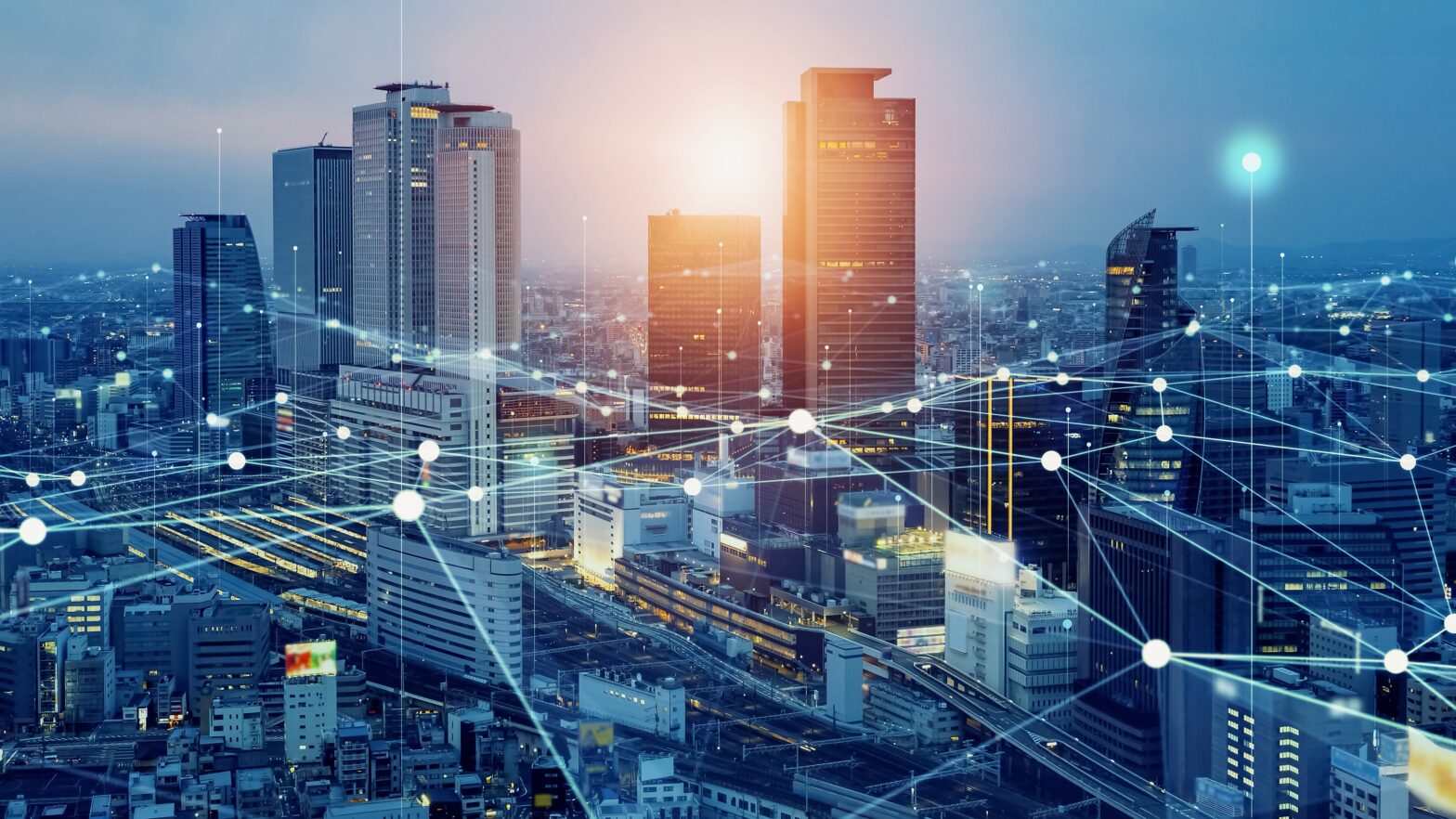Unlike what most people think…Smart buildings have been in development since 1947 with the invention of the first transistor. Yeap, you read that right! The concept may be modern, but the technological advancement behind a smart building is probably as old as (or older than) most parents.
So…what exactly is a smart building?
Well, it is a structure that uses advanced technology to provide a safer, more comfortable, and more efficient environment for its occupants.
And the best part?
Smart buildings aren’t limited to modern constructions! Even old buildings can be transformed into smart buildings with the right technology.
One such example is the Edge in Amsterdam, which has been dubbed “the world’s most sustainable office building.”
But there are many more smart buildings that have been around for some time now.
What technologies are used in smart buildings?
Some smart building technologies include:
- Internet of Things (IoT) sensors
Well, for starters, there are Internet of Things (IoT) sensors that can track everything from temperature and humidity to occupancy and energy use.
- AI & ML
And don’t forget about artificial intelligence(AI) and machine learning (ML). These powerful tools can help buildings optimize energy use and make automatic decisions to improve operations.
- Robots and drones
Smart buildings can also incorporate robots and drones to perform tasks like cleaning and maintenance and even use augmented and virtual reality to create immersive experiences for their occupants.
- Building management systems
And (of course) no smart building would be complete without a top-of-the-line building management system. This is the brain that keeps everything running smoothly, after all.
From smart homes to offices! What applications can you find?
These high-tech solutions are popping up in all sorts of properties all over the world… from sleek office buildings to cozy homes and everything in between.
So, what kinds of applications can you find in a smart building?
Well, let’s start with energy usage –> smart technologies can help control lighting, climate, and air quality to optimize energy consumption and reduce waste.
And when it comes to security and access control, smart building solutions are second to none.
Elevator controls, water monitoring, occupancy monitoring – you name it, smart buildings have got it covered!
But perhaps the most exciting application of smart building technology is predictive maintenance.
That’s right… by using data and analytics, a smart building can anticipate maintenance needs before they become big problems.
(Talk about staying ahead of the curve!)
All in all, smart building technologies are changing the game when it comes to architecture and design.

What’s driving the smart building market growth?
First things first…Do you know that by 2026, the global smart building market size is projected to grow at a CAGR of 10.9% to reach over USD 121.6 billion?
So, what is driving this growth? Various factors.
Let’s look at them one by one.
- increased demand for energy-efficient systems
- increasing energy consumption,
- advancement in loT and PoE solutions,
- increasing net zero and regulatory changes
Increased demand for energy-efficient systems
Unless you have been living under a rock, you’ve heard all about the energy crisis since the beginning of 2021.
The world has become more eco-conscious, and as energy prices continue to rise, intelligent building solutions that optimize energy use are becoming more popular than ever.
Whether it’s through lighting control, HVAC systems, or other smart technologies, these systems are helping buildings reduce their carbon footprint and save money on utility bills.
Increasing energy consumption
As more and more people move to urban areas and demand for energy-intensive technologies (like AI and cryptocurrency mining) continues to grow, buildings are under more pressure than ever to optimize their energy use.
Smart building technologies that monitor energy consumption and automatically adjust systems to reduce waste are therefore becoming a MUST-HAVE for any modern building.
Advancement in loT and PoE solutions
These cutting-edge technologies are making it easier than ever to connect and control smart devices throughout a building, from sensors and thermostats to security systems and access controls.
As loT and PoE solutions continue to evolve, we can expect to see even more sophisticated smart building solutions in the years to come.
Increasing net zero and regulatory changes
Many governments worldwide have been setting ambitious targets for carbon reduction and energy efficiency.
This has made smart building technologies a key way for buildings to meet these targets and comply with regulations.
The benefits and restrictions of a smart building
The benefits
- Data analysis
- Better insights
- Positive environmental impact
- More comfort
- Better health and safety
- Maintenance
- Reduced energy costs
For a more detailed analysis of these and other benefits, check out this article.
Restrictions
- Privacy concerns
- Cyber security
- Connectivity
- Initial installation costs
The present and future of smart buildings!

Can a smart building make a business efficient?
You bet!
You can probably guess how efficient it can make a business from all the benefits and usages of the smart building technologies we mentioned.
With smart building technologies, businesses can:
- optimize their operations,
- reduce costs ALL kinds of costs,
- enhance productivity in countless ways.
For starters, smart buildings can help businesses save on energy costs.
Smart lighting and climate control can be automatically adjusted to match occupancy levels, reducing energy waste and utility bills.
This means that businesses can save money while also reducing their carbon footprint…a win-win for everyone involved!
But that’s just the tip of the iceberg.
Smart building technologies can also help businesses improve productivity.
For example, smart scheduling systems can help employees easily reserve meeting rooms and workspaces… reducing scheduling conflicts and wasted time.
And let’s not forget about the impact on employee health and well-being.
Smart building technologies, like air quality and water monitoring systems, can help ensure that the workplace is healthy and safe, reducing the risk of illness and absenteeism.
Meanwhile, smart lighting systems can be adjusted to mimic natural light, promoting better sleep and enhancing employee mood and productivity.
But perhaps the biggest advantage of smart buildings is the wealth of data they provide.
With sensors and monitoring systems throughout the building, businesses can gather real-time insights into everything from energy usage and occupancy levels to equipment performance and maintenance needs.
This data can be used to identify inefficiencies, optimize operations, and improve overall business performance.
From smart buildings…to smart CITIES!
Smart buildings are just the beginning of the smart city revolution.
With IoT-connected devices and advanced data analytics, smart cities can tackle a wide range of urban challenges and improve the lives of citizens in countless ways.
The goal of smart cities is to tackle the many urban challenges that communities face.
The data collected from smart cities can be used to achieve a wide range of objectives, such as:
- reducing global carbon emissions,
- improving manufacturing efficiency,
- identifying and preventing power outages,
- reducing traffic congestion,
- monitoring crime and natural disasters.
Reducing global carbon emissions
One major benefit of smart cities is their potential to reduce global carbon emissions.
By using sensors and data analytics to monitor energy usage, traffic flow, and other key factors, cities can identify areas for improvement and implement more efficient and sustainable systems.
Improving manufacturing efficiency
Another advantage of smart cities is their ability to improve manufacturing efficiency.
Manufacturers can optimize their operations and reduce waste by -> analyzing data on energy usage, equipment performance, and other factors.
Address and prevent power outages.
By monitoring the electrical grid and identifying potential issues before they escalate, cities can ensure that residents can access reliable electricity AT ALL TIMES.
(This is particularly important in areas prone to extreme weather events, where power outages can downright be life-threatening.)
Traffic congestions
Reducing traffic congestion is another major benefit of smart cities (we mentioned it a bit before).
By using real-time data on traffic flow, cities can optimize transportation routes and reduce congestion, leading to faster commute times.
This also benefits businesses by improving access to their locations and reducing delivery times.
Monitor for crimes and natural disasters.
Finally, smart cities can help monitor crime and natural disasters, providing an early warning system that can help prevent or minimize damage.
By using sensors and analytics to identify unusual activity, cities can take proactive steps to keep citizens safe and secure.
***
These are just a few of the many potential applications of smart cities.
As more buildings come online (and become more flexible, people-centric, and sustainable), cities will continue to grow and evolve, resulting in increased functionality and efficiency.
Wrapping it up: What’s next?
The global market for smart building technology is rapidly growing, and businesses realize the benefits of integrating these technologies into their operations.
As smart buildings become more prevalent, they are laying the foundation for smart cities. They have the potential to address many urban challenges faced by communities around the world.
Moreover…the emergence of the 5G technology is a huge opportunity for the growth and further development of smart buildings.
After all, the VAST amount of data generated by IoT-enabled devices in smart buildings can be efficiently transported, interpreted, and acted upon thanks to 5G technology.
The possibilities of smart buildings and smart cities are endless, and it is exciting to imagine what the future holds as technology evolves.
